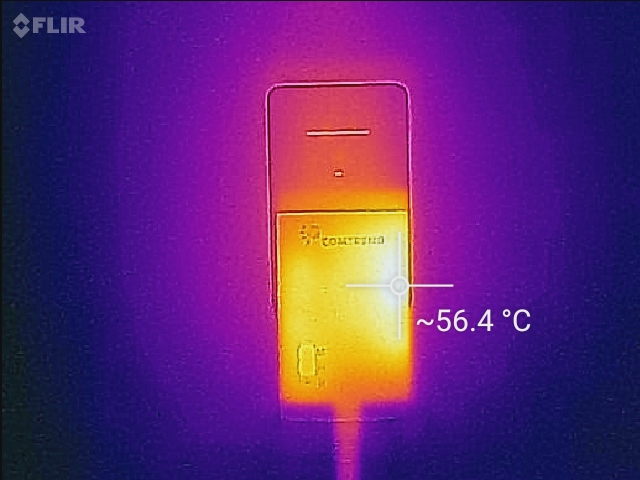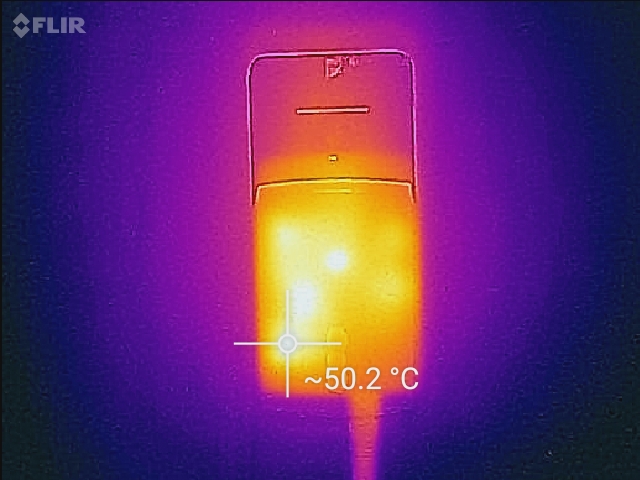Comtrend PG-9172 Powerline Adapter Review: G.hn Gets Primed for Retail Push
by Ganesh T S on May 3, 2016 8:30 AM EST- Posted in
- Powerline Adapters
- Networking
- Marvell
- G.hn
- HomePlug
- Comtrend
Miscellaneous Aspects - Power, Thermals and Coexistence
Powerline adapters tend to get quite warm under sustained loading conditions. The power consumption is also an interesting aspect, since these devices are kept on 24x7. We evaluated these aspects for the Comtrend PG-9172 and the ZyXEL PLA5405. While the master node was left as-is (with the DHCP server NUC connected) in the 'M' location in the floorplan, the other member of the adapter pair was connected to a Ubiquiti Networks mFi In-Wall outlet in the same room as Node C. The In-Wall outlet allows measurement of instantaneous power consumption.
A stress test was set up with iperf servers and clients running on the NUCs at either end. 16-stream TCP benchmarks were processed for 30 minutes from both sides simultaneously.
Under these sustained loading conditions, the G.hn pair was able to maintain 60 Mbps+ uplink and downlink, while the HPAV2 MIMO pair was able to maintain around 40 Mbps
At the end of the 30 minute stress test, thermal photographs of both units were taken using the FLIR One for Android thermal camera.
We find that the G.hn adapter ran hotter (more than 56C) compared to the HPAV2 adapter (around 50C)
The power consumption of the adapters was also recorded under different scenarios. Under stress, the HPAV2 adapter does consume more power than the G.hn adapter. However, the thermal design must be better in the former in order to maintain a lower case temperature. On the other hand, under idle conditions, the disabling of the power saving feature by default in the G.hn adapter results in much higher power consumption compared to the HPAV2 adapter.
| PLC Adapter Power Consumption | ||
| Scenario | Comtrend PG-9172 | ZyXEL PLA5405 |
| Normal (No Traffic) | 3.19 W | 1.98 W |
| Stress Test (TCP) | 3.85 W | 3.97 W |
Coexistence is important if G.hn adapters end up getting installed in apartments with pre-existing HomePlug networks. Marvell has been working on updating the firmware to improve coexistence. Even though our review units were not equipped with the latest coexistence firmware, we decided to test out whether HomePlug and G.hn networks could co-exist. Towards this, we created a HomePlug AV2 network to extend our primary network (192.168.1.0 subnet) and retained the G.hn network described above. The HPAV2 network's master node was connected to a power outlet in the wall adjacent to the G.hn master node.
Traffic in our primary HPAV2 network was restricted to a series of pings (over Wi-Fi to a PC connected to the second powerline adapter). In this scenario, we processed the stress test on the G.hn network. There is a clear loss of bandwidth, and the consistency exhibited in the previous run was no longer present. However, it did manage to stay above 35 Mbps all through. On the HPAV2 side, we lost around 4 packets out of a few thousand. On the whole, our conclusion regarding coexistence is that it works in our limited testing. Future firmware updates might help lessen the impact on the HPAV2 network while also enabling the G.hn network to have better performance consistency.















48 Comments
View All Comments
FATCamaro - Tuesday, May 3, 2016 - link
There are curbside transformers that would completely mangle any data on the line for internet. I'm sure you've seen these buzzing boxes around you?Manch - Wednesday, May 4, 2016 - link
A long time ago there was research into using power lines for data transmission. The idea was to use the em field around the lines to carry the signal. Spurious signals can be picked up like this so why not intentionally use it to send/receive data.That research laid the ground work which turned into this tech.GTVic - Wednesday, May 4, 2016 - link
That is called native encryption.willis936 - Tuesday, May 3, 2016 - link
Phone lines have much better properties for signals. Also every house in America already has a phone line thanks to the Communications Act.cigar3tte - Tuesday, May 3, 2016 - link
But older homes are also that ones that don't have the proper wirings to support powerline networking.Ninhalem - Tuesday, May 3, 2016 - link
I used power line networking to great effect in a home built in 1892. Wiring is dependent on how good the builders were at the time. You can have modern home builders and electricians who shouldn't have been allowed to touch power tools. I find that most construction from the turn of the 20th century and in the 1930's was some of the best construction ever.JoeyJoJo123 - Tuesday, May 3, 2016 - link
What is "Anectdotal Evidence" for $5000, Jerry.Samus - Tuesday, May 3, 2016 - link
LOL, are you denying his claim that pre-WWII construction was superior to modern construction quality?Having a major in architecture and having worked in construction, most modern residential homes are built to last 30-50 years. Materials and quality of construction. The only advantage is the homes are more efficient and have more creature comforts.
In the 20's and 30's, that mentality didn't exist. Things were just built. Well.
Prior to the 70's, the concept of "flipping" also didn't exist. Homes were built and bought to live in forever, much of the time planned to be passed down through the family. These days, almost half of homes are purchased for short term occupancy. aka, 'flipping.'
Buying modern construction is scary, especially if you don't know what to look out for. I'd rather have a 100 year old used and abused home than a 10 year old cookie cutter that was built cheap and has already been through 3 clueless owners.
sor - Wednesday, May 4, 2016 - link
I don't know. I've seen my fair share of knob and tube, insulation that has settled and compacted, moisture barrier issues, rot, insufficient foundations. Most homes that are that old have already had major work done or are piles of crap that either need to be stripped to the studs or they're just run down homes that people put up with because of cost. You can find the occasional well built home, but since building code and inspections were sparse it's a total crap shoot. Looking at the past thinking everything was well built is looking with Rose colored glasses.eek2121 - Wednesday, May 4, 2016 - link
Took the words right out of my mouth.